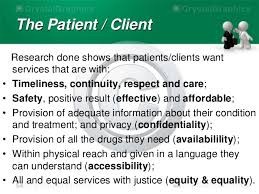Know your rights as a patient
 As it is, many people are afraid of hospitals; they relate hospital with sickness and death, some people find their fear so deeply rooted that they feel threatened and overwhelmed when they need to go to a hospital. It’s a common sentiment for so many number of years that medical practice means the physicians make decisions for their patients. This mistaken view has gradually been displaced by the fact that a patient has sovereignty and rights in decision making about his well being and the entire process of getting cured. He can thus share his views and with the doctors. In the recent years we see a sea change in doctor-patient relationships; they are very different now than they were just a few decades ago. However, conflicts still abound as the medical community and those it serves struggle to define their respective roles.
As it is, many people are afraid of hospitals; they relate hospital with sickness and death, some people find their fear so deeply rooted that they feel threatened and overwhelmed when they need to go to a hospital. It’s a common sentiment for so many number of years that medical practice means the physicians make decisions for their patients. This mistaken view has gradually been displaced by the fact that a patient has sovereignty and rights in decision making about his well being and the entire process of getting cured. He can thus share his views and with the doctors. In the recent years we see a sea change in doctor-patient relationships; they are very different now than they were just a few decades ago. However, conflicts still abound as the medical community and those it serves struggle to define their respective roles.
Patients’ rights differ in different countries and in different jurisdictions which often depend upon existing cultural and social standards. Different models of the patient-physician relationship usually represent the citizen-state relationship, and these standards shape particular rights to which patients are entitled. In North America and Europe, for instance, there are at least four models which depict this relationship: the paternalistic model, the informative model, the interpretive model, and the deliberative model. Each of these suggests different professional obligations of the physician toward the patient. For example, in the paternalistic model, the best interests of the patient as judged by the clinical expert are valued above the provision of comprehensive medical information and decision-making power to the patient. As in the informative model, by contrast, sees the patient as a consumer who is in the best position to judge what is in her own interest, and thus views the doctor as chiefly a provider of information. There continues to be enormous debate about how best to envisage this relationship, but there is also growing international consensus that all patients have a fundamental right to privacy, to the confidentiality of their medical information, to consent to or to refuse treatment, and to be informed about relevant risk to them of medical procedures.
 Cleveland Clinic, located in Cleveland, Ohio, is a not-for-profit multispecialty academic medical center that combines clinical and hospital care with research and education. Cleveland Clinic was founded in 1921 by four renowned physicians with a vision of providing outstanding patient care based upon the principles of cooperation, compassion and innovation. U.S.News & World Report consistently names Cleveland Clinic as one of the nation’s best hospitals in its annual “America’s Best Hospitals” survey. Do you know, about 2,000 full-time salaried physicians and researchers and 7,600 nurses at Cleveland Clinic represent more than 100 medical specialties and subspecialties? In addition to its main campus, Cleveland Clinic operates from nine regional hospitals in Northeast Ohio, Cleveland Clinic Florida, Lou Ruvo Center for Brain Health in Las Vegas and Cleveland Clinic Canada. Millions of patients from so many countries in the world visit Cleveland for different ailments. Cleveland Clinic has set benchmarking in patient’s and patient’s family’s experience in the hospital. It constantly reviews opportunities to improve the patient experience. By monitoring real-time patient feedback, individual departments are able to review their results and prioritize patient experience improvement objectives. We have examples of Cleveland Clinic for the best medical practices.
Cleveland Clinic, located in Cleveland, Ohio, is a not-for-profit multispecialty academic medical center that combines clinical and hospital care with research and education. Cleveland Clinic was founded in 1921 by four renowned physicians with a vision of providing outstanding patient care based upon the principles of cooperation, compassion and innovation. U.S.News & World Report consistently names Cleveland Clinic as one of the nation’s best hospitals in its annual “America’s Best Hospitals” survey. Do you know, about 2,000 full-time salaried physicians and researchers and 7,600 nurses at Cleveland Clinic represent more than 100 medical specialties and subspecialties? In addition to its main campus, Cleveland Clinic operates from nine regional hospitals in Northeast Ohio, Cleveland Clinic Florida, Lou Ruvo Center for Brain Health in Las Vegas and Cleveland Clinic Canada. Millions of patients from so many countries in the world visit Cleveland for different ailments. Cleveland Clinic has set benchmarking in patient’s and patient’s family’s experience in the hospital. It constantly reviews opportunities to improve the patient experience. By monitoring real-time patient feedback, individual departments are able to review their results and prioritize patient experience improvement objectives. We have examples of Cleveland Clinic for the best medical practices.
Right of information: Please be aware that as a patient you have right to have information regarding risks, alternatives, and success rates. The information must be presented to you in language which you understand. As a patients or close relative of patient, you have a right to have description of the recommended treatment or procedure. Also, you can seek description of the risks and benefits, particularly exploring the risk of serious bodily disability or death. You can ask questions to seek information of alternative treatments and the risks and benefits of trying out the alternatives. You must get to know from the physician the probable results if no treatment is undertaken. The probability of success and a definition of what the doctor means by success; yes, you must ask questions to gauge the so called success elements. Ask questions to know length and challenges of healing. And, you are free to ask any other information generally provided by the physician.
Patient’s consent: Please understand that doctors do not have the right to touch or treat a patient without the patient’s approval because the patient is the one who must subsist with the consequences and deal with any discomfort caused by treatment. A doctor can be held liable for committing a series if the doctor touches the patient without first obtaining the patient’s consent. Consent must be voluntary, competent, and well informed. Voluntary means that, when the patient gives consent, he or she is free from extreme pressure and is not intoxicated or under the influence of medication and that the doctor has not coerced the patient into giving consent. The law presumes that an adult is competent, but competency may be an issue in numerous instances. Competence is typically only challenged when a patient disagrees with a doctor’s recommended treatment or refuses treatment altogether. If an individual understands the information presented regarding treatment, she or he is competent to consent to or refuse treatment.
 Medical practice is not free from legal, moral, and ethical questions. Hippocratic Oath is one of the oldest binding documents in history, the Oath written by Hippocrates is still held sacred by physicians: to treat the ill to the best of one’s ability, to preserve a patient’s privacy, to teach the secrets of medicine to the next generation, and so on.
Medical practice is not free from legal, moral, and ethical questions. Hippocratic Oath is one of the oldest binding documents in history, the Oath written by Hippocrates is still held sacred by physicians: to treat the ill to the best of one’s ability, to preserve a patient’s privacy, to teach the secrets of medicine to the next generation, and so on.
Emergency: In an emergency situation, a patient has a right to treatment, regardless of his ability to pay. If a situation is likely to cause death, serious injury, or disability if not attended to promptly, it is an emergency. Cardiac arrest, heavy bleeding, profound shock, severe head injuries, and acute psychotic states are some examples of emergencies. Less obvious situations can also be emergencies: broken bones, fever, and cuts requiring stitches may also require immediate treatment. Please understand that both public and private hospitals have a duty to administer medical care to a person experiencing an emergency. If a hospital has emergency facilities, it is legally required to provide appropriate treatment to a person experiencing an emergency. If the hospital is unable to provide emergency services, it must provide a referral for appropriate treatment. Hospitals cannot refuse to treat forthcoming patients on the basis of race, religion, or national origin, or refuse to treat someone with HIV or AIDS.
However, there is no universal right to be admitted to a hospital in a nonemergency situation. In nonemergency cases, admission rights depend largely on the specific hospital, but basing admission on ability to pay is severely limited by statutes, regulations, and judicial decisions.
Medical Experimentation: medical progress and medical experimentation have always gone hand in hand, but patients’ rights have sometimes been ignored in the process. Sometimes patients are completely unaware of the experimentation. Experimentation has also taken place in settings in which individuals may have extreme difficulty asserting their rights, such as in prisons, mental institutions, the military, and residences for the mentally disabled. Legitimate experimentation requires informed consent that may be withdrawn at any time by the patient.
Every state has enacted advance medical directive legislation, but the laws differ widely. Advance medical directives are documents that are made at a time when a person has full decision-making capabilities and are used to direct medical care in the future when this capacity is lost. Many statutes are narrowly drawn and specify that they apply only to illnesses when death is imminent rather than illnesses requiring long-term life support, such as in end-stage lung, heart, or kidney failure; multiple sclerosis; paraplegia; and persistent vegetative state.
Right to die: A number of cases have addressed the right to refuse life-sustaining medical treatment. Broadly speaking, under certain circumstances a person may have a right to refuse life-sustaining medical treatment or to have life-sustaining treatment withdrawn. On the one side in these cases is the patient’s interest in autonomy, privacy, and bodily integrity. This side must be balanced against the state’s traditional interests in the preservation of life, prevention of suicide, protection of dependents, and the protection of the integrity of the medical profession.
Confidentiality: confidentiality between a doctor and patient means that a doctor has the express or implied duty not to disclose information received from the patient to anyone not directly involved with the patient’s care. Confidentiality is important so that healthcare providers have knowledge of all facts, regardless of how personal or embarrassing, that might have a bearing on a patient’s health. Patients must feel that it is safe to communicate such information freely. Although this theory drives doctor-patient confidentiality, the reality is that many people have routine and legitimate access to a patient’s records. A hospital patient might have several doctors, nurses, and support personnel on every shift, and a patient might also see a therapist, nutritionist, or pharmacologist, to name a few. The law requires some confidential information to be reported to authorities. For example, birth and death certificates must be filed; child abuse cases must be reported; and infectious, contagious, or communicable diseases must be reported. In addition, confidential information may also be disclosed pursuant to a judicial proceeding or to notify a person to whom a patient may pose a danger.
Human Rights: The Universal Declaration of Human Rights has been instrumental in preserving the notion of human dignity in international law, providing a legal and moral grounding for improved standards of care on the basis of our basic responsibilities towards each other as members of the “human family”, and giving important guidance on critical social, legal and ethical issues. But there remains a great deal of work to be done to clarify the relationship between human rights and right to health, including patient rights. Recognizing this challenge, the United Nations Commission on Human Rights (UNHCR) has designated a Special Forum to provide it with a report that examines and clarifies the broader relationship between human rights and the right to health. This report has great importance for the World Health Organization, whose mission is to ensure “health for all”.
 How much information is considered adequate? Reasonable physician standard: this standard allows the physician to determine what information is appropriate to disclose. However, this standard is often insufficient, since most research shows that the typically physicians tell the patient very little. Reasonable patient standard: what would the average patient need to know in order to be an informed participant in the decision? This standard focuses on considering what a typical patient would need to know in order to understand the decision at hand. And, lastly the subjective standard: what would this particular patient need to know and understand in order to make an informed decision? This standard is the most challenging to incorporate into practice, since it requires tailoring information to each patient.
How much information is considered adequate? Reasonable physician standard: this standard allows the physician to determine what information is appropriate to disclose. However, this standard is often insufficient, since most research shows that the typically physicians tell the patient very little. Reasonable patient standard: what would the average patient need to know in order to be an informed participant in the decision? This standard focuses on considering what a typical patient would need to know in order to understand the decision at hand. And, lastly the subjective standard: what would this particular patient need to know and understand in order to make an informed decision? This standard is the most challenging to incorporate into practice, since it requires tailoring information to each patient.
I want to conclude my article with this beautiful quote of Albert Schweitzer – the medical missionary in Africa “Each patient carries his own doctor inside him. They come to us now knowing this truth. We are at our best when we give the doctor who resides within each patient a chance to go to work” I think, this quote sums up our rights as patients.












































